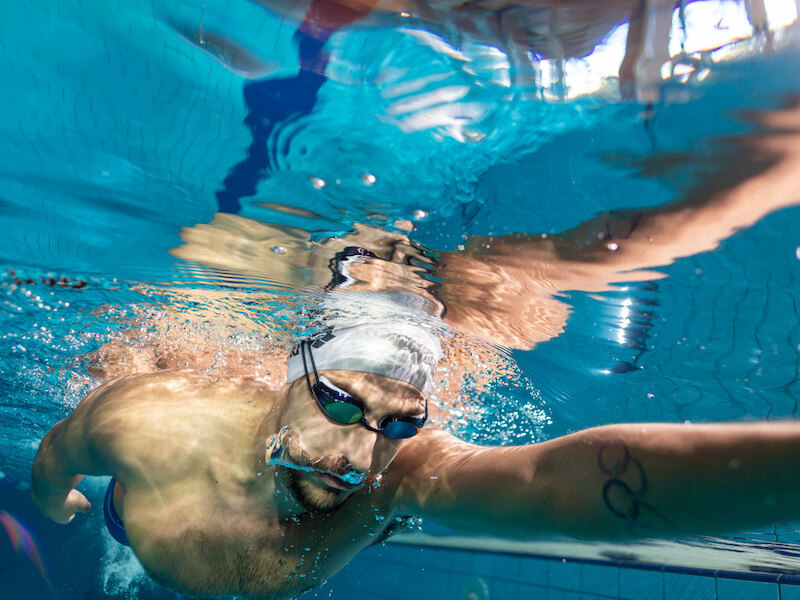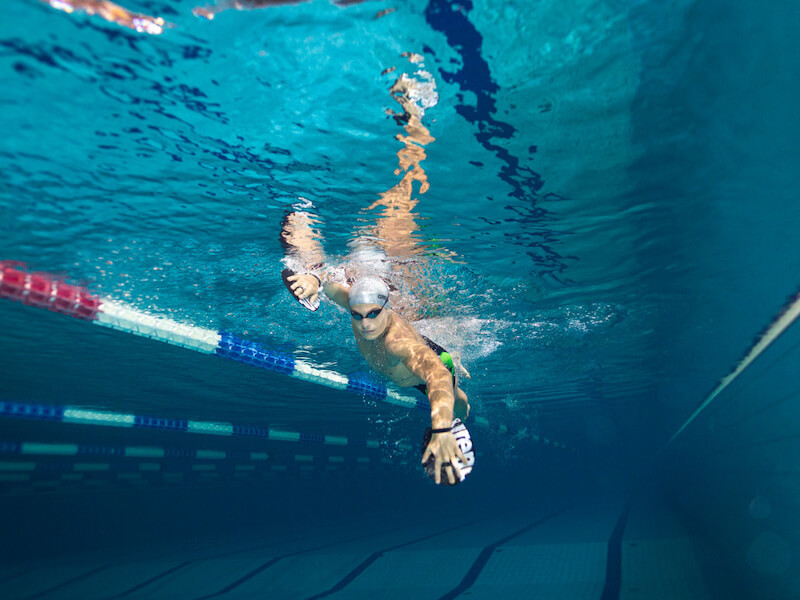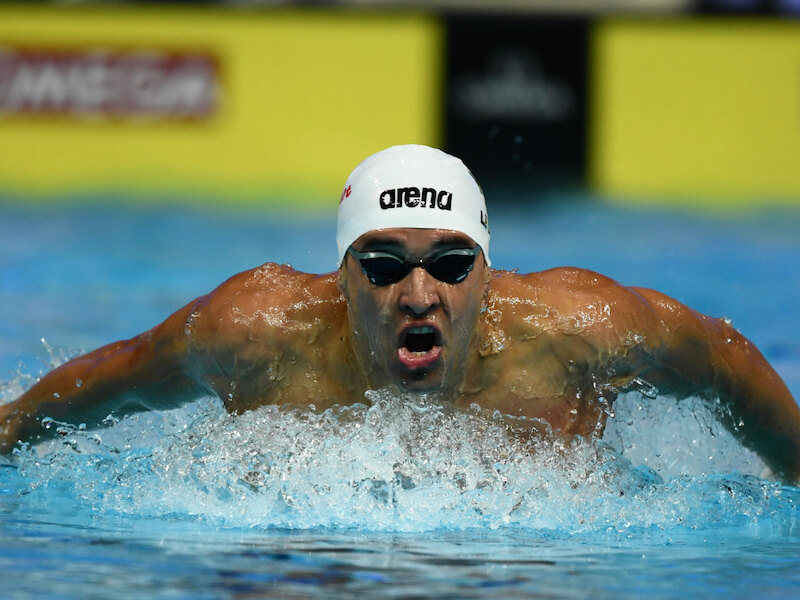Hypoxic Training: The Art of Breathing Less
Adding a completely new type of workout to your existing regimen can be equal parts intimidating and exciting. Hypoxic training may sound like an extreme form of exercise for enhanced sports performance, but it actually confronts one of swimming’s most important factors that separates it from other sports. The all important factor is, of course, your breathing.
In this article, we will give a brief introduction into what hypoxic training is and how it can be an enhancement to your aerobic and anaerobic abilities in the water. Then, we’ll find out why you should add hypoxic training to your exercise training. Finally, we will share some simple hypoxic training methods that will boost your aerobic capacity.
What Is Hypoxic Training?

The medical definition of hypoxia is a pathological state caused by an inadequate oxygen supply to the entire organism.
Training hypoxically (also known as altitude training) is when an athlete purposely breathes oxygen-reduced air. This can involve changing the conditions of their training or even where they live and sleep. This method of training may conjure up visions of people preparing themselves for acclimatization in high-altitude hypoxic conditions, such as brave ascents up the Nepalese mountains. But it also has serious training benefits at sea level. High-intensity hypoxic endurance training is used by boxers, cyclists and many other low-altitude elite athletes.
Hypoxic training is different when applied to swimming because there is already a natural oxygen deficit in the sport. There’s no need for climbing up huge mountains or investing in altitude chambers. It’s all about changing your breathing. Hypoxic training in swimming refers to a specific type of training performed using a different breathing pattern than the conventional method of breathing every stroke or every three strokes.
In the following two subsections we’ll see how training methods differ between high altitude athletes and swimmers. We’ll find out the difference between “fake altitude” and “real altitude” in hypoxic training. And we’ll see how every Olympic stroke can benefit from hypoxic training.
High-Altitude Applications
Hypoxic training was initially intended to simulate high-altitude training, where altitude exposure is added to a training program. The idea is that the partial pressure of oxygen in the air is reduced and so oxygen flows through the red blood cells more slowly. But studies have shown that hypoxic training does not reduce the oxygen-enriched arterial blood flow to tissues, meaning it doesn’t recreate the conditions found during altitude training.
However, hypoxic training definitely has its advantages; it can help strengthen the body’s skeletal muscles and raise metabolic rate. One of the most common hypoxic training methods is intermittent hypoxic training in which athletes alternate between breathing low-oxygen (hypoxic) air and ambient (normoxic) air.
Another example of hypoxic training is “living high-training low.” This is where endurance athletes sleep in low-oxygen high-altitude conditions to enhance their sea-level performance. They then train at low altitudes, reaping the benefits of high altitude acclimatization. Using real high altitude like this combines low pressure with low oxygen and is known as hypobaric hypoxia.
Some endurance athletes try to emulate high-altitude conditions at sea level by lowering their oxygen intake (an example of this is an altitude chamber) in an environment of normal air pressure. This results in normobaric hypoxia, or “fake altitude,” but research is still yet to show if it is less effective than the real thing.
Hypoxic Training for Swimmers
Within the world of competitive swimming, hypoxic training is a technique used by swimmers to improve their tolerance within the water when confronted with a deficit of oxygen. This is achieved by methodically limiting breathing during training sessions.
Hypoxic training brings about a state called hypercapnia (from the Greek hyper: over or too much, and kapnos: smoke) or, in other words, an increase in the carbon dioxide (CO2) levels of the red blood cells (and decrease in oxygen saturation). So, hypercapnia triggers off a breathing reflex. If you struggle to hold your breath at certain times while swimming (during the exertion of a race or a prolonged underwater phase), it is the amount of carbon dioxide in your body that increases and not the oxygen supply, and this means you will need air.
The more you practice taking fewer breaths, the better you will become at controlling the breathing reflex triggered by hypercapnia. So you will be able to swim longer, breathing less. It is imperative to remember that hypoxic training never requires you to hold your breath, but to master breathing out very slowly when your face is in the water. Holding your breath can lead to blackouts and is not a long-term training solution.
That is why sports science has found that hypoxic training is excellent for the overall athletic performance of freestyle and butterfly swimmers. Backstroke swimmers will also notice the benefits during the underwater phases using the butterfly leg kick, and breaststrokers will also be able to improve by practicing this skill during the underwater phases. In other words, hypoxic exposure can benefit every Olympic stroke.
You can improve your technique very quickly in the short term, mitigating the effects of hypercapnia in just a few weeks by teaching your body how to breathe less when necessary.
Why Should You Add Hypoxic Training to Your Routines?

Now that you know what hypoxic training is, we should find out if it’s the right type of workout for you. You may train with more conventional workouts such as normoxic interval training (basically interval training with the usual breathing you would use while swimming). So, what is it that makes hypoxic training stand out?
Raise Your Resting Heart Rate
You can use a hypoxic set as a warm up before your training or when trying to raise your resting heart rate for a swim meet. A low-intensity hypoxic set can raise your heart rate to the desired level without overworking your muscles.
Overcome Stroke Barriers
During normal training, we take lots of breaths, and therefore, we perform lots of catches and other breath-specific movements. Limiting the amount of times you take a breath during a set will make you more aware of any mistakes you are making during the breath phase.
Improve Your Confidence
Swimming with less breathing will quickly teach you how much your body can still perform even under hypoxic conditions. This can help to improve your confidence while training and competing. It will give you a better idea of how much you have in the tank, and you’ll be more aware of the power of your abilities even after you have taken a poor breath.
Hypoxic Training Exercises
You don’t need to be an endurance athlete to add hypoxic sessions to your exercise training, but it could help you become one. Endurance performance can benefit from intermittent hypoxic training (commonly known as IHT). The exercises below are a mix of intermittent and more vanilla workouts that will improve the exercise performance of all swimmers:
- 4-8 x 25 meters freestyle with one minute of rest in “hypoxia 1” — i.e., only breathing in once every 25 meters. When you feel confident with this kind of training, try and alternate it with “hypoxia 0,” or in other words, without breathing in for the entire 25 meters. This type of training is known as intermittent hypoxia.
- 4 x 50 meters freestyle with one minute of rest, attempting to vary how often you breathe during the 50 meters. To begin with, try breathing once every 25 meters, and then, try swimming the first 25 meters without breathing and the second 25 meters breathing only once.
- 3 × 100 meters freestyle with one minute of rest, altering your breathing pattern every 25 meters. Breathe every three strokes for 25 meters, then every five strokes for 25 meters, then every three strokes for 25 meters, and then every seven strokes for 25 meters.
- 8 × 25 meters butterfly leg kick during the underwater phase with one minute of rest.
- 4 × 50 meters swimming 15 meters underwater with a butterfly leg kick off the wall at the end of each length.
Remember that hypoxic training asks a lot from your cardiovascular system and is physiologically stressful, so you are advised to introduce it very carefully into your weekly training sessions.
Hypoxic Training Can Help Any Swimmer

Hypoxic training can essentially teach you to swim more and breathe less. This is great because even though breathing is essential to good athletic performance (and your survival), it does slow you down.
Don’t forget that hypoxic training can help you to gain confidence in the water, make you more cognizant of your stroke nuances, and could allow you to quickly raise your heart rate when you need to.
There’s no question hypoxic training will benefit you. Breathing is an essential part of swimming, and the fact that you are surrounded by water, which stops you from breathing, adds a layer of complexity and danger that we don’t see in other sports. The question should be, why haven’t you started yet?
If you are serious about your training and would like the tools and swimwear to help you get the results you desire, check out arena’s store for a range of equipment to suit any future adaptations you may make to your training.
Written by:
arena coaches
Swim coaches, trainers and experts will give you all kinds of tips for performing at your best in both training and races.







